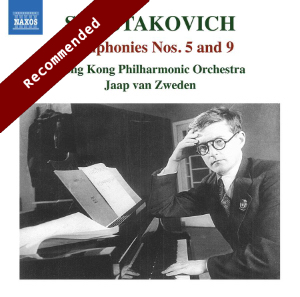
Dmitry Shostakovich (1906-1975)
Symphony No. 5 in D minor, Op. 47 (1937)
Symphony No. 9 in E flat major, Op. 70 (1945)
Hong Kong Philharmonic Orchestra/Jaap van Zweden
rec. 2022, Hong Kong Cultural Centre Concert Hall
Naxos 8.574549 [67]
As a regular reviewer, I always feel something of a fraud when reviewing Shostakovich, in that I am not one of those who feels a natural affinity for his music but I have persisted because so many people whose musical judgement I respect are devotees of his output. Having persevered, I have certainly made progress, hence my choice to tackle this new recording of two of his more approachable symphonies. My points of reference for comparison are hardly controversial: Rudolf Barshai for both – in fact, all – the symphonies, Bernstein, Mackerras and Stokowski for No. 5, and Mata for No. 9 – although I appreciate that there is any number of alternatives and although Mata’s Ninth might not necessarily be a top recommendation, I have always liked it and it has had some good reviews.
Although he was open to revising his opinion, Shostakovich indicated through both his metronome markings and comments on conductors’ performances that in general he preferred swifter speeds and van Zweden certainly does not hang about in either of these symphonies; indeed, they are among the fastest, exceeded for paciness in the Fifth only by Stokowski. In the Ninth, in particular, several interpreters begin the perky “going to the circus” circus theme with far too draggy a beat; no danger of that here. This is bright, snappy playing, rhythmically tight and alert, punctuated by the shafts and splinters of sound from the piercing piccolo – great fun but always sharp and sarcastic. The moody, haunting, ambivalent clarinet solo which opens the Moderato over dark, pulsing pizzicato strings, then threads its way through the movement as it passed to other woodwind instruments, is beautifully played. The Presto is suitably frenetic and riotous and only a fool could miss the edgy menace barely cloaked by its superficial glee. That threat is made more overt by the splendidly minatory brass chords opening the Largo and the mournful bassoon solo – again, both really well executed. The concluding Allegretto drives relentlessly towards the anticipated apotheosis – then defaults into a trivial romp which so audibly mocks the puffed-up Vohzd (the Russian equivalent of “Führer) without apology. The power and homogeneity of the orchestral playing here are mightily impressive.
This symphony seems to suit van Zweden temperamentally and I cannot imagine it better delivered, given the expertise and virtuosity of the Hong Kong Philharmonic. As much as I have enjoyed the Mata recording which was my introduction to this work, this new Naxos version has even more bite and propulsion and matches Barshai for punch; Mata is fine in the lyrical interludes but van Zweden scores in the more frantic passages such as the assertive trumpet solo in the Presto – and the Naxos sound is also considerably more vivid than both.
Comparison with other conductors’ timings in the Fifth is interesting; as I mentioned, Stokowski is the fastest in every movement, sometimes by a considerable margin; Bernstein typically goes to extremes: very fast in the second and final movements, very slow in the Moderato and Largo; Barshai is slightly more moderate all round than van Zweden, but not significantly so – and, incidentally, Mackerras, in a much-admired recording from 1994 with the RPO, in first-rate sound and which I like very much, is generally a tad more moderate than Barshai, so that places van Zweden on the more urgent end of the range.
Urgent it may be, but it never sounds rushed and the singing string tone of the violins in their long lines over the steady, anapaestic “dum-dum-da” of the lower strings in the first movement is a joy. Snarling brass, high, shrieking woodwind and rattling percussion usher in the martial episode and the momentum never flags throughout until we are treated to some mellow flute and haunting celesta in the soft, eery coda – this is lovely playing. Bernstein is more overtly, even searingly, dramatic but does not enjoy such good sound and his tendency to linger too long risks letting the line sag here and in the Largo; Stokowski’s control is masterly but his sound is considerably worse; for me, both Mackerras and van Zweden have the immeasurable advantages of impeccable sound and achieving an ideally subtle balance between the moods. There is nothing too subtle or understated about van Zweden’s bluff, whole-hearted treatment of the Scherzo, which seems to underline a strong kinship with Prokofiev’s Romeo and Juliet; somehow, a Dutchman directing a Chinese orchestra sounds very Russian indeed! The yearning Largo is heartrendingly played; once again, the depth of orchestral tone is striking and the impact of the tremolo passage beginning at 8:14 overpowering – as with the Ninth, the sheer weight of the sound this orchestra can produce is a revelation. That spills over into the riotous finale which first hurtles forwards, then in the central section halts as if in bemused fashion and deciding where to go, then resumes its headlong rush towards its ambiguously triumphant conclusion. The playing here is marvellous, especially from the trumpet and drum.
Very full and helpful notes by Richard Whitehouse put the seal on this valuable issue.
Barshai’s bargain box on Brilliant Classics (review ~ review ~ review) is still widely considered the best all-round option for a complete set of the symphonies but this single Naxos CD certainly provides the ideal introductory sampler for the tyro embarking on getting to know Shostakovich – and indeed might also be considered an upgrade for the more experienced listener.
Ralph Moore
Help us financially by purchasing from





















